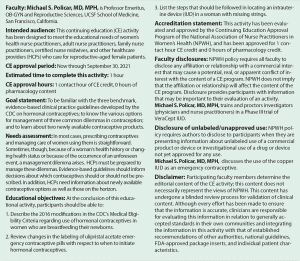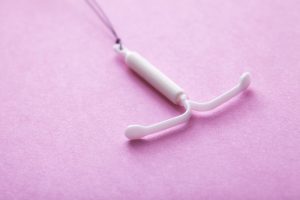

The provision of high-quality contraceptive services is supported by three benchmark, evidence-based clinical practice guidelines developed by the CDC. The U.S. Medical Eligibility Criteria for Contraceptive Use, 2016B, known as the USMEC, provides recommendations on contraceptive safety, particularly for women with chronic diseases.1 The USMEC provides a safety rating for more than 60 conditions in categories of contraceptives such as combined hormonal contraceptives (CHCs), which include combined oral contraceptives (COCs), the contraceptive patch, and the contraceptive vaginal ring; progestin-only contraceptives (POCs), which include depot medroxyprogesterone acetate (DMPA), progestin-only implants, and progestin-only pills (POPs); and intrauterine devices (IUDs) such as the levonorgestrel intrauterine system (LNG-IUS) and the copper IUD (Cu-IUD). In addition, safety information is provided for emergency contraceptives (ECs), barrier methods, fertility awareness-based methods (FABMs), lactational amenorrhea, withdrawal, and sterilization. The safety categories are numbered 1 through 4 as follows:
1. No restriction for the use of a given contraceptive method; the method can be used safely.
2. Advantages of using the method generally outweigh the theoretical or proven risks; the method can generally be used safely, but more than the usual follow-up is needed.
3. Theoretical or proven risks usually outweigh the advantages of using the method; clinical judgment should determine whether the given method can be used safely in a particular woman. In these cases, use of the contraceptive method, particularly one that is highly effective, will be safer than an unintended pregnancy
4. Unacceptable health risk if the contraceptive method is used; do not use the method.
The third guideline, Providing Quality Family Planning Services, 2014D, known as the QFP, which was developed jointly by the U.S. Office of Population Affairs and the CDC, is a resource that fills in the gaps on family planning topics not included in the USMEC or SPR.3 These topics include contraceptive counseling, pregnancy testing and options counseling, achieving pregnancy, basic infertility, preconception health, and preventive health screening for women and men.
Two of the three aforementioned guidelines, the USMEC and the SPR, were updates to the 2012 versions. The updates in these 2016 publications were based on the publication of important new studies, as well as on changes to the World Health Organization (WHO) MEC and SPR recommendations. In the USMEC, safety categories were lowered or raised for several conditions, especially the use of CHCs in women with migraine headaches and the use of POCs in lactating women. Several conditions were included for the first time (e.g., cystic fibrosis, multiple sclerosis) and certain drug–drug interactions were updated (e.g., selective serotonin reuptake inhibitors and St. John’s wort; hormonal methods in women using antiretrovirals for HIV infection). The most important modification to the USMEC was the inclusion of ulipristal acetate (UPA) in the EC section.1 An important update to the SPR is advising a woman to start or resume hormonal contraception no sooner than 5 days after use of UPA.2
Dilemma #1: Use of hormonal contraceptives and breastfeeding
Judy is a 30-year-old woman who experienced an uncomplicated vaginal birth at 37 weeks. Her newborn daughter weighed 2,704 g and is healthy. Judy plans to fully breastfeed her infant and requests a prescription for contraception before discharge on postpartum day 2. She is not interested in an IUD at this time. Which hormonal methods are safe for her to use? When can she safely start using the method chosen?
Judy and her HCP discuss the pros and cons of CHCs, which include the pill, the patch, and the ring.
Effect on lactation
Among CHCs, COCs have been studied the most with respect to safety of use in lactating mothers and their infants. COCs have been found to have no effect on the quality (content) of breast milk in terms of its amounts of protein, fat, iron, and copper. In terms of the quantity of breast milk, studies conducted in the 1960s and 1970s showed that women who initiated COCs containing high-dose estrogen before the establishment of lactation had a reduced quantity of breast milk.4 By contrast, more recent studies have shown that women who initiated COCs containing low-dose estrogen after lactation was established had minimal, if any, changes in breast milk quantity.5 Nevertheless, concern about the adverse effect of CHCs on breast milk supply still exists—especially in the context of women having difficulty with breastfeeding their newborn for a variety of reasons.
Use of COCs appears to influence the duration of breastfeeding. One early study showed that COC users breastfed for an average of 3.7 months, versus an average of 4.6 months for women who did not use COCs.6 However, a 2016 updated systematic review of 15 RCTs and cohort studies showed an inconsistent impact of COCs on breastfeeding duration and success.7
Research has shown that the ethinyl estradiol dose reaching newborns via COC users’ breast milk is similar to the amount they would receive from the mother’s daily ovarian estradiol production. Furthermore, studies have shown no effect of COCs on breastfed infants’ development, including neurologic development and growth rates.7
Changes in maternal clotting factors persist for up to 6 weeks after childbirth, resulting in an increased risk for venous thromboembolism (VTE) over this time period. Use of CHCs in this setting of increased hypercoagulability could potentially increase VTE risk even more. Given the fact that lactating women rarely ovulate in the first 6 weeks after delivery, the risk of using a CHC far outweighs the benefit because the likelihood of ovulation is so low. As a consequence, the USMEC risk categories are 4 for women <21 days postpartum; 3 for those 21-29 days postpartum, with or without other VTE risk factors* or 30 42 days postpartum with other VTE risk factors*; 2 for those 30-42 days postpartum with no other VTE risk factors; and 1 for those >42 days postpartum.1
Progestin-only contraceptives
Unlike CHCs, POCs have no effect on the quality or quantity of breast milk.8,9 Greater VTE risks are not expected with POCs because they do not affect
 clotting factors.10 The CDC commissioned a systematic review of 47 studies to assess the effects of POCs when used by lactating women.11 The evidence failed to demonstrate adverse breastfeeding outcomes or health outcomes in infants whose mothers took POCs. USMEC risk categories for lactating women who use POPs (those available in the United States contain norethindrone), DMPA, or the etonogestrel implant are 2 during postpartum days 1-29 and 1 for postpartum day 30 onward.1
clotting factors.10 The CDC commissioned a systematic review of 47 studies to assess the effects of POCs when used by lactating women.11 The evidence failed to demonstrate adverse breastfeeding outcomes or health outcomes in infants whose mothers took POCs. USMEC risk categories for lactating women who use POPs (those available in the United States contain norethindrone), DMPA, or the etonogestrel implant are 2 during postpartum days 1-29 and 1 for postpartum day 30 onward.1Discussions about contraceptive use by lactating women should consider each woman’s desire to breastfeed, her risk for breastfeeding difficulties, and her risk for unintended pregnancy.1 The following clarification was added to the 2016 USMEC regarding progestin-only methods: “Certain women might be at risk for breastfeeding difficulties, such as women with previous breastfeeding difficulties, certain medical conditions, and certain perinatal complications and those who deliver preterm. For these women, as for all women, discussions about contraception for breastfeeding women should include information about risks, benefits, and alternatives.”1
The Academy of Breast-Feeding Medicine has a different take on the use of hormonal contraceptives in breastfeeding women. According to Clinical Protocol #13, HCPs should inform women that CHCs may decrease milk supply, especially in the early postpartum period.12 Hormonal methods should be discouraged in any of these settings: existing low milk supply or history of lactation failure, history of breast surgery, multiple births, preterm birth, or compromised health of mother and/or infant.
Because Judy chooses to breastfeed exclusively, she is highly unlikely to become pregnant in the first 6 weeks postpartum. She wants the many health benefits of long-term breastfeeding that will accrue to both her infant and herself. During this time, she is at significantly increased risk for VTE and should avoid any of the CHCs. If she is fully breastfeeding (no additional nutrition for her newborn), she can rely on lactational amenorrhea as her contraceptive method for at least 12 weeks postpartum, and even longer (but no more than 6 months) if she remains amenorrheic. If she insists on starting a method before leaving the hospital, POPs, DMPA, or a contraceptive implant are all good options—as long as she is reminded to return for advice on another method if she has difficulties with breastfeeding.
Dilemma #2: Initiation of hormonal contraceptives after use of ulipristalacetate
Mary Ann is a 25-year-old woman presenting with a request for an EC. She had unprotected intercourse (UPI) with a new partner 4 days ago, on day 10 of her usual 30-day cycle. In addition, she wants to start a method of contraception as soon as possible. Weighing 200 pounds and standing 5 feet, 4 inches, she has a BMI of 34 kg/ m2, placing her in the obese category. What should be done for Mary Ann in terms of her immediate need for an EC and her long-term need for birth control?
Emergency contraceptives available
The single-dose levonorgestrel (LNG) tablet (1.5 mg) is labeled for use within 72 hours of UPI. Its efficacy in preventing pregnancy is good when taken 0-72 hours following UPI and moderate when taken 72-120 hours following UPI. LNG-containing EC products available in the U.S. include Plan B One-Step® and multiple generic one-dose tablets. No physical assessment is required prior to use; in fact, single-dose LNG is widely available without a prescription in pharmacies across the country.
The next option is ulipristal acetate or UPA (Ella®), which prevents ovulation, even with follicles up to 18-20 mm. UPA is taken orally in a single 30-mg dose and is labeled for use up to 5 days after the last UPI. In a meta-analysis of the efficacy of UPA versus LNG, given 0-72 hours following the last UPI, 22 pregnancies occurred in 1,617 women in the UPA group (1.4%) versus 35 pregnancies in 1,625 women in the LNG group (2.2%) (odds ratio, 0.58, 0.33-0.99; P = 0.046).13
Efficacy of ECs in overweight/ obese women
The aforementioned meta-analysis comparing the effects of LNG and UPA as ECs showed that, relative to women of normal weight (BMI <25), overweight women (BMI, 25-30) and obese women (BMI ≥30) had pregnancy rates that were 1.5 times greater and >3 times greater, respectively.16,17 For obese women, the risk was significantly greater for those taking LNG than for those taking UPA. Two studies have shown that absorption of the hormones used in COCs is slower in obese women than it is in women of normal weight.18,19 With ECs, immediate absorption is important; this delay could explain the lower efficacy in obese women.20
Starting hormonal contraception after receiving ulipristal
For women who are better candidates than Mary Ann for UPA, the following information is important to know. UPA is a selective progesterone-receptor (PR) modulator that blocks the effect of progesterone at many sites. Despite the proven efficacy of this EC method, there was concern that starting a progestin-containing contraceptive immediately after taking UPA would displace UPA from PRs, thereby reducing UPA’s effectiveness. Sure enough, a small pharmacodynamic study showed that initiating a desogestrel (DSG)-containing POP the day after UPA administration significantly reduced the ovulation-delaying effect of UPA.21 In this study, whereas ovulation occurred in only 1 (3%) of 29 UPA-only cycles in the first 5 days, it occurred in 13 (45%) of 29 UPA+DSG cycles. These results prompted a change in the product labeling for Ella22: After using this product, if a woman wants to use hormonal contraception, she should do so no sooner than 5 days after UPA administration. If she has sexual intercourse, she should use a reliable barrier method until her next menstrual period.
Dilemma #3: Management of a lost intrauterine device string
Rosa is a 45-year-old G3P3 who had an IUD inserted 8 years previously. She remembers that it had a T shape but is unsure which type of IUD it is. She reports that she has been unable to feel the string for the past 2 months; before that time, she checked for it sporadically. A speculum examination confirms that no string is present at the external cervical os.
Whenever an HCP encounters a patient with a “missing” IUD string, four possibilities should come to mind: (1) The IUD is in situ, with the string coiled in the cervical canal or endometrial cavity or simply cut short, broken, or severed; (2) The woman has an intrauterine pregnancy, with the IUD string pulled up into the expanding uterine cavity; (3) Asymptomatic expulsion has occurred; or (4) In the unlikely event that the uterus was perforated when the IUD was placed, the string may not be visible because the IUD is embedded in the myometrium or translocated through the uterine wall and into the abdominal cavity.
Recommended steps in management
Before performing any intervention, the first step in management of a lost string is to perform an office pregnancy test. If the result is positive, the pregnancy must be located and dated (see subsection on Pregnancy in next section). If the result is negative, the HCP can probe the cervical canal with an endocervical brush, using a spinning motion to catch the string. (This step is taken next because it is assumed, albeit not yet confirmed, that the IUD is in situ and that the HCP wants to position the string so that the woman can find it the next time she checks for it.) If this maneuver is not effective, the HCP can ask the woman whether she wants to keep the IUD—if it is found to be in the correct position—or if she prefers to have it removed.
If the w oman wants to keep using the IUD, and it has not expired, the next step is performance of a pelvic ultrasound, either in the office or in a diagnostic imaging center. If the IUD is identified as being in situ, it can remain in place until the expiration date or until the woman has problems with it or wants to become pregnant. If the IUD is not identified in the uterine cavity, the next step is performance of a kidney/ureter/bladder x-ray (KUB) to determine whether it is outside the uterus but in the abdominal cavity. If so, a translocation is diagnosed. If an IUD is not seen on the pelvic ultrasound or the KUB, then expulsion is diagnosed. These steps can be performed in a single visit by ordering a pelvic ultrasound first and authorizing an immediate KUB if the IUD is not identified.
oman wants to keep using the IUD, and it has not expired, the next step is performance of a pelvic ultrasound, either in the office or in a diagnostic imaging center. If the IUD is identified as being in situ, it can remain in place until the expiration date or until the woman has problems with it or wants to become pregnant. If the IUD is not identified in the uterine cavity, the next step is performance of a kidney/ureter/bladder x-ray (KUB) to determine whether it is outside the uterus but in the abdominal cavity. If so, a translocation is diagnosed. If an IUD is not seen on the pelvic ultrasound or the KUB, then expulsion is diagnosed. These steps can be performed in a single visit by ordering a pelvic ultrasound first and authorizing an immediate KUB if the IUD is not identified.
If an IUD frame or string cannot be grasped or otherwise detected by feel in the cavity, a combination of pelvic ultrasound and a KUB, as described earlier, should be ordered. In this case, the likelihood of asymptomatic expulsion is high, but deep embedment or translocation is possible. If the IUD is grasped but cannot be removed, it likely is embedded, in which case 3D ultrasound or computed tomography (CT) of the pelvis can suggest whether a hysteroscopic or laparoscopic approach is more likely to be successful. Under ideal circumstances, these imaging tests are ordered by the OB/GYN physician who will perform the extraction in the surgical center or operating room, depending on preference, in order to avoid duplication of an expensive imaging procedure.
If the woman’s office pregnancy test result is positive, pelvic ultrasound is used to determine the site of the pregnancy. If it is ectopic, the woman should be referred immediately to an OB/GYN physician for medical or surgical treatment of the ectopic pregnancy. If it is intrauterine and viable, the woman needs to know that the risks of adverse pregnancy outcomes are greater in the setting of IUD retention than if it were to be removed.25 Removal is recommended when the strings are visible or when the device can be removed safely from the cervical canal. If pregnancy termination is planned, then the IUD can be removed during a surgical abortion or before a medication abortion.
If the woman decides to continue an intrauterine pregnancy and the IUD strings are not visible, the HCP should not attempt removal. Instead the HCP should counsel the woman regarding the increased risks of spontaneous abortion, septic abortion, chorioamnionitis, and preterm delivery. The woman should undergo increased surveillance during antenatal care. Because the IUD is outside the amniotic sac, the fetus is not at greater risk for birth defects. Insufficient evidence exists regarding adverse fetal effects of small exposure to LNG during gestation.25
Expulsion of the IUD occurs in 2% of insertions within the first year. Risk of expulsion is related to the HCP’s skill at fundal placement; the woman’s age, parity, and uterine configuration; time since insertion (increased risk within the first 6 months), and timing of insertion (menses, postpartum, post-abortion); for example the risk is greater if the device is inserted within 48 hours of childbirth.26 A woman with an unnoticed expulsion may present with pregnancy. A woman with a partial expulsion may present with pelvic pain, cramps, or intermenstrual bleeding or she may mention that the IUD string is longer than she previously perceived.26
The overall incidence of uterine perforation as a result of IUD insertion is about 0.1%,27 although the rate is significantly higher— 0.6%—in postpartum women. Depending on how the IUD is positioned and where it has translocated, it is removed via hysteroscopy or laparoscopy. Because the Cu-IUD, compared with the LNG-IUS, can cause greater inflammation and more adhesions, it must be extracted promptly via laparoscopy. The LNG-IUS is less reactive, but most experts recommend laparoscopic removal as well. If advanced imaging such as 3D ultrasound or CT of the pelvis shows that the IUD is embedded in the myometrium, it usually can be removed hysteroscopically. However, if imaging shows that none of the IUD frame is accessible in the endometrium and most of the device protrudes through the myometrium and into the abdominal cavity, laparoscopic removal is indicated.
A pelvic ultrasound shows that Rosa’s IUD is properly situated in the uterine cavity. Because the device is identified as an LNG-IUS that was inserted 8 years earlier, she and her HCP decide that it should be removed and replaced. The first procedure is accomplished in the office with an alligator forceps with simultaneous ultrasound and the old device is replaced by a new one.
Newly approved contraceptives
The FDA approved two new contraceptive products in 2018.
AnnoveraTM CVR (contraceptive vaginal ring) This ring containing segesterone acetate and ethinyl estradiol prevents ovulation for 1 year (13 cycles). The woman inserts it into the vagina herself, leaves it in place for 21 days, and then removes it for 7 days to allow a withdrawal bleed. The ring can be removed over the 21-day period for intercourse and cleaning, but not for longer than 2 hours. This product is like NuvaRing® with respect to the amount of progestin and estrogen released and the diameter, but Annovera is twice as thick (8.4 mm vs. 4 mm) because each ring is used for 13 cycles, not 1 cycle. According to the manufacturer, Annovera CVR is the “first woman-controlled, procedure-free, long-acting, reversible birth control product.” It is longer acting than other methods, but because it does need to be removed and tended periodically, unlike the IUD and implant, which are “forgettable,” it does not qualify as being a true long-acting reversible contraceptive method.
Natural Cycles® app This FABM is the first and only fertility monitoring app with FDA approval to be marketed as a contraceptive. It can be used for either contraception or timing intercourse to become pregnant. With respect to its mechanism of action, it relies on cycle pattern and basal body temperature, not cervical mucus. Use of the app requires the use of a special basal body temperature thermometer that signals the smartphone with the temperature reading. The app factors in current basal body temperature and a woman’s past menstrual and monitoring history in predicting future ovulatory events so that she knows when she can engage in, or avoid, intercourse. Compared with other FABMs, this app has these advantages: It has withstood FDA scrutiny, it integrates objective data about prior ovulation patterns, it requires minimal user intervention, and it has a clear user interface. However, relative to other FABMs, its failure rate is similar and it requires disciplined use by both partners. To minimize contraceptive failure, this app is best used with a barrier method on “red” days.
On the horizon
For decades, contraceptives have been prescribed by HCPs and furnished by clinics or pharmacies. Newer alternatives include having registered nurses or pharmacists prescribe and furnish CHCs via standing orders. But the “delivery system” of the future—and, by the way, the future is here—involves provision of CHCs via telehealth or apps, including NurxE, PRJKT RUBYF, MavenG, virtuwell.comH, pandia healthI, Pill ClubJ, and LemonaidK. The lattermost five apps offer a Skype-like interaction with a nurse practitioner or other clinician. The app Planned Parenthood DirectL is usable in about half the states in the U.S.
One day soon, in a strange counterpoint to storks delivering babies, drones may be delivering pills, patches, and rings to whoever orders them.
References
1. Curtis KM, Tepper NK, Jatlaoui TC, et al. U.S. Medical Eligibility Criteria for Contraceptive Use, 2016. MMWR Recomm Rep. 2016;65(3):1-103. cdc.gov/mmwr/ volumes/65/rr/pdfs/rr6503.pdf
2. Curtis KM, Jatlaoui TC, Tepper NK, et al. U.S. Selected Practice Recommendations for Contraceptive Use, 2016. MMWR Recomm Rep. 2016;65(4):1-66. cdc.gov/mmwr/ volumes/65/rr/pdfs/rr6504.pdf
3. Gavin L, Moskosky S, Carter M, et al. Providing Quality Family Planning Services: Recommendations of CDC and the U.S. Office of Population Affairs. MMWR Recomm Rep. 2014;63(4):1-54. cdc.gov/mmwr/pdf/rr/rr6304.pdf
4. Effects of hormonal contraceptives on breast milk composition and infant growth. World Health Organization (WHO) Task Force on Oral Contraceptives. Stud Fam Plann. 1988;19(6 pt 1):361-369.
5. Espey E, Ogburn T, Leeman L, et al. Effect of progestin compared with combined oral contraceptive pills on lactation: a randomized controlled trial. Obstet Gynecol. 2012;119(1):5-13.
6. Nilsson S, Nygren KG, Johansson ED. d-Norgestrel concentrations in maternal plasma, milk, and child plasma during administration of oral contraceptives to nursing women. Am J Obstet Gynecol. 1977;129(2):178-184.
7. Tepper NK, Phillips SJ, Kapp N. et al. Combined hormonal contraceptive use among breastfeeding women: an updated systematic review. Contraception. 2016;94(3):262-274.
8. Truitt ST, Fraser AB, Grimes DA, et al. Combined hormonal versus nonhormonal versus progestin-only contraception in lactation. Cochrane Database Syst Rev. 2003;(2):CD003988.
9. Lopez LM1, Grey TW, Stuebe AM, et al. Combined hormonal versus nonhormonal versus progestin-only contraception in lactation. Cochrane Database Syst Rev. 2015;(3):CD003988.
10. Sitruk-Ware R. Hormonal contraception and thrombosis. Fertil Steril. 2016;106(6):1289-1294.
11. Phillips SJ, Tepper NK, Kapp N, et al. Progestogen-only contraceptive use among breastfeeding women: a systematic review. Contraception. 2016;94(3):226-252.
12 Berens P, Labbok M; Academy of Breastfeeding Medicine. ABM Clinical Protocol #13: Contraception During Breastfeeding, Revised 2015. Breastfeed Med. 2015;10(1):3-12. abm.memberclicks.net/assets/DOCUMENTS/ PROTOCOLS/13-contraception-and-breastfeeding-protocol-english.pdf
13. Glasier AF, Cameron ST, Fine PM, et al. Ulipristal acetate versus levonorgestrel for emergency contraception: a randomised non-inferiority trial and meta-analysis. Lancet. 2010;375(9714):555-562.
14. Cleland K, Haoping Z, Goldstuck N, et al. The efficacy of intrauterine devices for emergency contraception: a systemic review of 35 years of experience. Hum Reprod. 2012;27(7):1994-2000.
15. Wu S, Godfrey EM, Wojdyla D, et al. Copper T380A intrauterine device for emergency contraception: a prospective, multicentre, cohort clinical trial. BJOG. 2010;117(10):1205-1210.
16. Sanders JN, Turok DK, Royer PA, et al. One-year continuation of copper or levonorgestrel intrauterine devices initiated at the time of emergency contraception. Contraception. 2017;96(2):99-105.
17. Glasier A, Cameron ST, Blithe D, et al. Can we identify women at risk of pregnancy despite using emergency contraception? Data from randomized trials of ulipristal acetate and levonorgestrel. Contraception. 2011;84(4):363-367.
18. Edelman AB, Cherala G, Stanczyk FZ. Metabolism and pharmacokinetics of contraceptive steroids in obese women: a review. Contraception. 2010;82(4):314-323.
19. Westhoff CT, Torgal AL, Mayeda ER, et al. Ovarian suppression in normal-weight and obese women during oral contraceptive use. Obstet Gynecol. 2010;116(2 pt 2):275-283.
20. Rapkin RB, Creinin MD. Update: When it comes to the morning-after pill, physicians need a wake-up call. OBG Manage. 2011;23(8):16-24.
21. Brache V, Cochon L, Duijkers IJ, et al. A prospective, randomized, pharmacodynamic study of quick-starting a desogestrel progestin-only pill following ulipristal acetate for emergency contraception. Hum Reprod. 2015;30(12):2785-2793.
22. Ella prescribing information. Last updated June 2018. dailymed.nlm.nih.gov/dailymed/ drugInfo.cfm?setid=052bfe45c485-49e5-8fc4-51990b2efba4#LINK_94c46528-93c6-49a5aef1-3597044978d2
23. Prabhakaran S, Chuang A. In-office retrieval of intrauterine contraceptive devices with missing strings. Contraception. 2011;83(2):102-106.
24. Kottmann C, Troncoso M, Valenzuela I, et al. Ultrasound-guided extraction of intrauterine devices with nonvisible threads: 254 consecutive cases: an effective, noninvasive technique. J Ultrasound Med. 2019 Mar 18. Epub ahead of print.
25. Brahmi D, Steenland MW, Renner RM, et al. Pregnancy outcomes with an IUD in situ: a systematic review. Contraception. 2012;85(2):131-139.
26. World Health Organization. Medical Eligibility Criteria for Contraceptive Use. 2nd ed. Geneva, Switzerland: WHO; 2000.
27. Rowlands S, Oloto E, Horwell DH.Intrauterine devices and risk of uterine perforation: current perspectives. Open Access J Contracept. 2016;7:19-32. ncbi.nlm.nih. gov/pmc/articles/PMC5683155/
A. npwh.org/courses/home/details/1343
B. cdc.gov/mmwr/volumes/65/rr/pdfs/rr6503.pdf
C. cdc.gov/mmwr/volumes/65/rr/pdfs/rr6504.pdf
D. cdc.gov/mmwr/pdf/rr/rr6304.pdf E. nurx.com/
E. nurx.com/
F. prjktruby.com/
G. mavenclinic.com/
H. virtuwell.com/
I. pandiahealth.com/
J. thepillclub.com/
K. lemonaidhealth.com/
L. plannedparenthooddirect.org/


